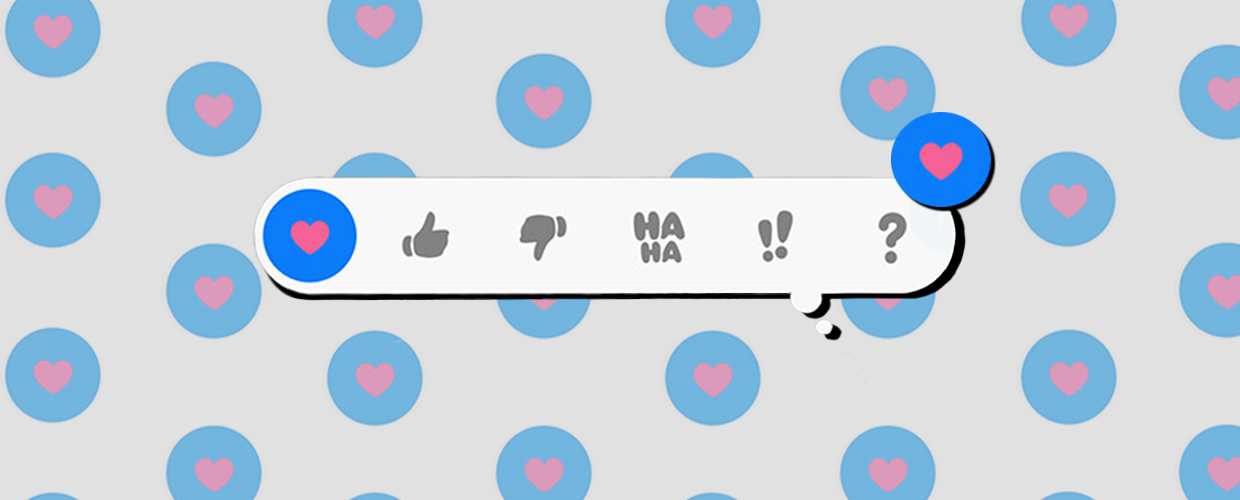Why I fell hard for the emoji tapback
I heart you, tiny heart


In his best-selling novel The Fault in Our Stars, John Green has a beautiful quote that I think about frequently: "I fell in love the way you fall asleep: slowly, and then all at once." Sigh.
That's pretty much me and the emoji tapback.
I don't remember how it started, exactly. I suspect that the first few times I saw them, I didn't know what they were. (I didn't even know they were called "tapbacks" until I started writing this piece.) If you are similarly confused, I'm talking about the ability, while using iMessage on your iPhone, to press onto someone else's text message, thereby bringing up several emoji options with which to respond: A heart, a thumbs up, a thumbs down, a HAHA, a duet of exclamation points, a question mark. With the exception of a sad face (there should be a sad face), iMessage has you covered with basically every human response there is. You don't even have to go to your emoji menu. It's all so easy.
The Week
Escape your echo chamber. Get the facts behind the news, plus analysis from multiple perspectives.

Sign up for The Week's Free Newsletters
From our morning news briefing to a weekly Good News Newsletter, get the best of The Week delivered directly to your inbox.
From our morning news briefing to a weekly Good News Newsletter, get the best of The Week delivered directly to your inbox.
And what a relief it is, to be seen like this.
Once I understood the magic, soon enough, I was tapping back on my own. It felt like the height of efficiency. I flipped easily from Instagram to Twitter to my messages, a seamless transition of liking or not liking things, as it may be. I'd give my Dad a thumbs-up when he asked if the snow thrower was working. I'd make my presence known in a group chat in which I didn't have time to engage properly, tossing in a few hearts and exclamation points. It was perfect for responding to messages while walking on cold streets; I could do it with a single finger.
In one meta moment, I returned a series of hearts with my own floating tapback heart. It wasn't just conversation. It was art.
Of course I realize I was — I am — being lazy. A phone call pales next to an in-person visit; texting isn't the same as actually engaging with our real voices. And the tapback is barely the ghost of a text, a wisp of a feeling or emotion, floating above actual words. It's already canned and prepared for you by someone else. It's a robot expression of human emotion. You couldn't even bother to dig up the barfy face? You couldn't say "Gotta go" instead of signaling that conversation was over by way of the HAHA emoji?
A free daily email with the biggest news stories of the day – and the best features from TheWeek.com
The tapback is also only applicable to the particular emotional categories the tapback covers and risks seeming truly insensitive when it doesn't. When you hear via text about Luke Perry's death, for instance, none of the current options will really convey how you feel. Tapback, give us what we need!
Despite the limitations, I persist in using the tapback. (I've already tapped back twice today.) It's soothing, something like a BuzzFeed quiz that tells you what sort of dog you are or a buffet filled with only your favorite foods.
And yes, I am probably a fogey for liking them. I turned to a 15-year-old for thoughts, and he explained, "I used to not like them — when it first came out, they used to keep getting in the way. Sometimes I'd accidentally click; it's a little bit annoying. But honestly, they don't affect my life in the slightest." He also confirmed "more old people do it, in my opinion."
He also taught me the best tapback trick: The ironic tapback, in which you write "Jen likes schnoodles" instead of actually using the tapback to indicate that Jen likes schnoodles. Or whatever it is you like/don't like/must HAHA !! about. It's a solid troll (at least, the first time).
I turned to my group text peers for their opinions: "Love them and find them very useful!" said one. (I tapped back with a heart.) "Useful but maybe a little lazy but coming around to them," said another. "Best for group chats where you want to support but not mess up the flow/waste people's time," said the third. The tapback is also truly brilliant for ending a conversation without having to say you're ending a conversation, which, in a time when everyone thinks they have something very important to say, might be its most important contribution to human flourishing.
In our time of great efficiency, the tapback isn't evil, it's just very handy — and maybe a little evil. But if it's evil, it's because we want it to be; it's because we, too, are a little bit evil. We have, after all, done all of this to ourselves, meting our feelings out in digital parcels, easy to deliver, easy to take on. But so much is already hard. And some things, like letting your best friend know you got home okay with a simple thumbs up to her question — no more, no less, a mere finger push of an assent that allows everyone to breathe a sigh of relief — should be easy.
Shouldn't they?
Jen Doll is the author of the memoir Save the Date: The Occasional Mortifications of a Serial Wedding Guest. She's also the managing editor for Mental Floss magazine and has written for The Atlantic, Esquire, Glamour, Marie Claire, The Hairpin, New York magazine, The New Republic, The New York Times Book Review The Village Voice, and other publications.
-
 Political cartoons for December 14
Political cartoons for December 14Cartoons Sunday's political cartoons include a new White House flag, Venezuela negotiations, and more
-
 Heavenly spectacle in the wilds of Canada
Heavenly spectacle in the wilds of CanadaThe Week Recommends ‘Mind-bending’ outpost for spotting animals – and the northern lights
-
 Facial recognition: a revolution in policing
Facial recognition: a revolution in policingTalking Point All 43 police forces in England and Wales are set to be granted access, with those against calling for increasing safeguards on the technology
